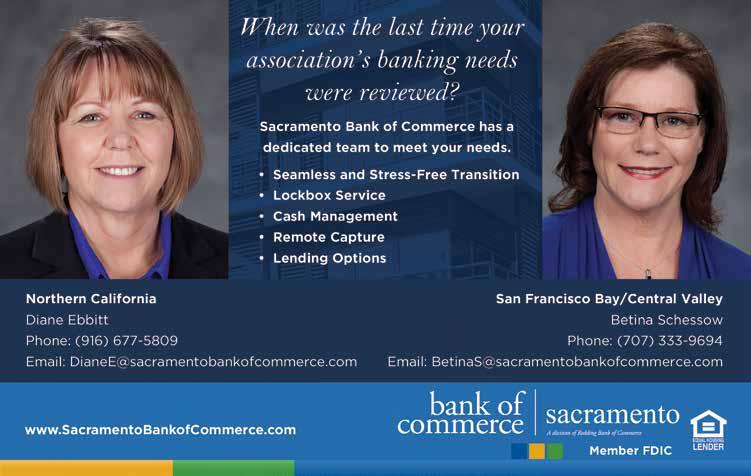
7 minute read
Sustainability Starts with You
By BOBBie GAFFN
, CCAM, PCAM
Sustainability is important in making sure we have and will continue to have the resources necessary to protect human health and our environment. Sustainability is based on one simple principle: Everything that we need for our survival and well-being depends, either directly or indirectly, on our natural environment.
Community associations should work to meet the community’s present needs, while also preserving the association’s essential character and ensuring future generations have the ability to meet their needs. This involves basing our community management decisions on the effects they may have on economic, environmental and social issues, including the impact financial decisions may have on individuals’ or the association’s income or spending; how community practices affect the air, water, land and global climate; and how each decision impacts the community’s welfare.
There are many things that we as community managers can do to assist our associations in achieving sustainability, including: • Replace light bulbs in buildings and common areas with brighter, more energy-efficient bulbs. Brighter lights will create a more pleasant atmosphere and increase security. (See sample case study on page 24 to show your boards how this approach can save money.) • Adopt sustainable landscape practices. Use quiet, zero emissions, battery-powered landscape equipment. Opt for natural or organic products for weed and pest control. • Reduce – Reuse – Recycle. Recycling is cost-effective waste management. The reprocessing of materials into new products prevents useful materials from being wasted, reduces the consumption of raw materials, and reduces energy. • Draft or restate the
CC&Rs to support and promote sustainability efforts.
Architecture and

Continued on page 10

Sustainability Starts with You Continued from page 9
landscape guidelines generally favor keeping the community looking neat and consistent. Associations should consider resetting the underlying values to expressly permit sustainable activities, such as vegetable gardens, composting, solar panels and architectural changes that promote more sustainable living.
Exploring Al l Options
To begin to achieve sustainability we must know what resources are available to us. The first place to look is the local utility companies. • Most water districts provide free water conservation devices, water audits, landscape workshops and water awareness programs to help with water conservation. Many districts have rebate and incentive programs that may reimburse the association tens of thousands of dollars for landscape renovation/water conservation projects, especially when they involve turf removal. • The gas company has a great deal of information available on energy efficiency. Many gas companies provide ways-tosave tools, incentives for energy efficiency improvements and rebates. • Your local electric company can provide information on energy efficiency, savings and incentives. Many electric companies will perform a free energy audit. Request a rate analysis to make sure your association is not being overcharged. Your electric company should also be able to provide information on electric vehicle charging. • Contact your waste management company to obtain information on local recycling. They can assist you with the disposal of household recyclables, as well as green waste, hazardous materials and e-waste. To begin to achieve sustainability we must know
In addition to the local what resources utility companies, speak to are available to us. your service providers. Ask your electrician or lighting expert about ways to reduce your electric consumption. Talk to your landscaper about water conservation and the introduction of eco-friendly maintenance techniques. Contact several solar providers to investigate the use of solar gas and electric for your communities.
The California Department of Conservation administers programs vital to California’s public safety, environment and economy that you may find helpful; visit www.conservatrion.ca.gov for more info. The Environmental Protection Agency (EPA) offers conservation tools, including the MyEnvironment website (www.epa.gov/myenvironment), which is a mapping tool that provides a wide range of information about environmental conditions in an area of your choice. The EPA also offers pollution prevention activities and resources that explain solid and hazardous waste issues to help you improve your community environment.
Implementing sustainability practices into your community associations may not seem like it makes a sizable impact. But, collectively all the efforts we as an industry make to conserve and protect can help create a better environment for us and future generations. It’s imperative that we put what we learn about sustainability into practice in our associations, including the benefits of solar energy, expanded xeric landscaping efforts and water conservation methods. These practices can help protect resources across California and the nation for years to come.

Bobbie Gaffney, CCAM, PCAM, is President of The Gaffney Group, Inc. in Palm Springs.

In today’s vernacular, the word “sustainability” most often refers to ecological and environmental issues. And, in fact, much of this issue of Vision magazine highlights the physical aspects of the communities we manage and how we might make those communities more environmentally responsible.
But what about the sustainability of an organization? The Board of Directors is charged with the responsibility of ensuring that CACM, as a member-based association, is sustainable by meeting the needs of the present without compromising the ability of future members to meet the needs of the organization. And, what does this really mean about our Board actions today? Over the past few months, and on the Board’s behalf, I have sent messages regarding the pending retirement of CACM’s President & CEO, Karen Conlon. The great news is I have heard from several members directly, which has led to many discussions about the Board process in our search for a new CEO. A few of the more engaging conversations included questions about why the Board felt it necessary to hire an executive search firm: Why go outside our industry? Why not promote automatically from in-house staff? Why does the process take so long? Simply put, we began with the end in mind. We recognized that while Karen came into her position with a background in common interest developments, CACM requires a CEO that has direct background in working with large, not-for-profit member organizations that are similar to, but different from, HOAs. (Insight into this career path can be found through the American Society of Association Executives at www.asaecenter.org.) We also want whomever is finally selected to be set up for success. Following Karen in the CEO role is going to be extremely challenging; she has served as the CEO for more than 22 years and in many ways is an iconic symbol of CACM. Stepping into the CEO shoes is a daunting task. Had we simply promoted from existing staff, there would have been significant feedback and political ramifications – plus, a handful of CACM members expressed interest in applying for the position. If the Board had failed to create an open application process, any internal candidate could potentially be faced with suggestion and innuendo that the position wasn’t earned. An important side note: any active board member is explicitly prohibited from
applying for the CEO position. So, if a board member wished to submit an application for the CEO position, he or she would be required to resign from the Board first.
As we all know, a thoughtful and careful process is often a lengthy process. By using an independent, skilled and objective third-party executive search firm, we hope to ensure the selection process is unbiased and conducted with high standards. Once the search firm was selected, effort was required to outline and confirm the overall profile for the position itself; we had to quantify what skills were needed and expected for this important role at CACM. Candidates must then proceed through the search firm interview process before review and potential interviews with the search committee. And, finally, the Board is involved with the final approval and selection of our new CEO.
We know that Karen, as an individual, is irreplaceable. Through these steps, however, we plan to find a CEO that can meet the needs and expectations of today’s members, as well as consider the future of CACM and lead our members to that future.

On behalf of the CACM Board, Melinda Young, CCAM, PCAM Board Chair





